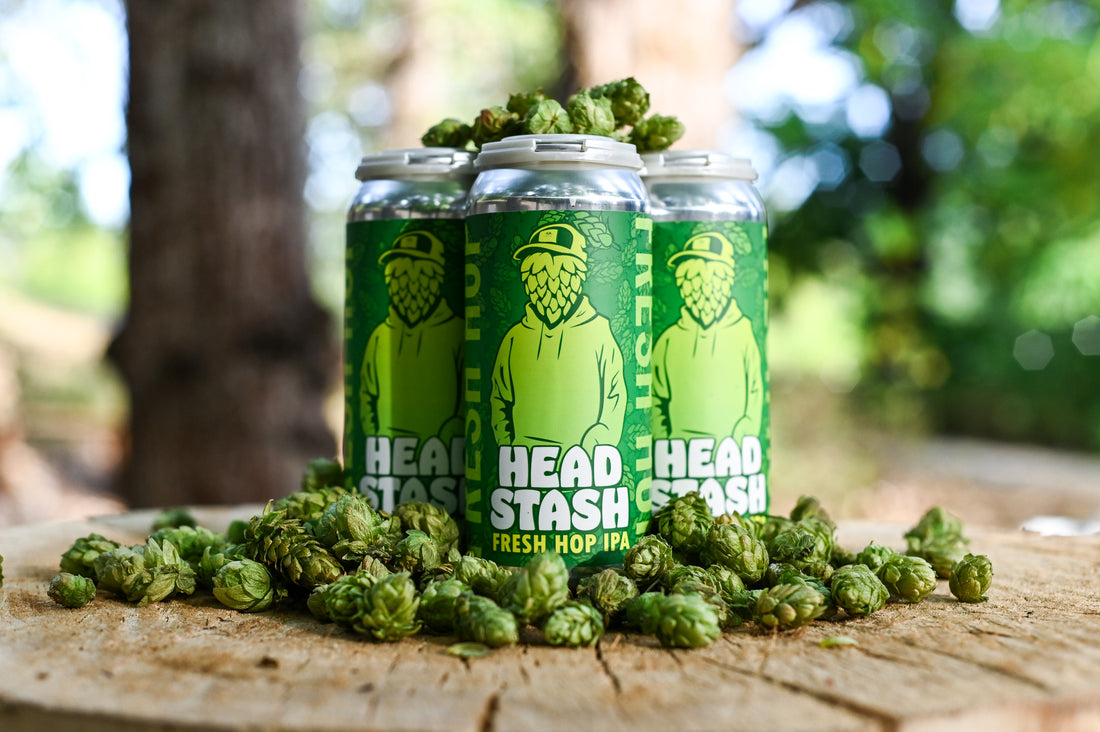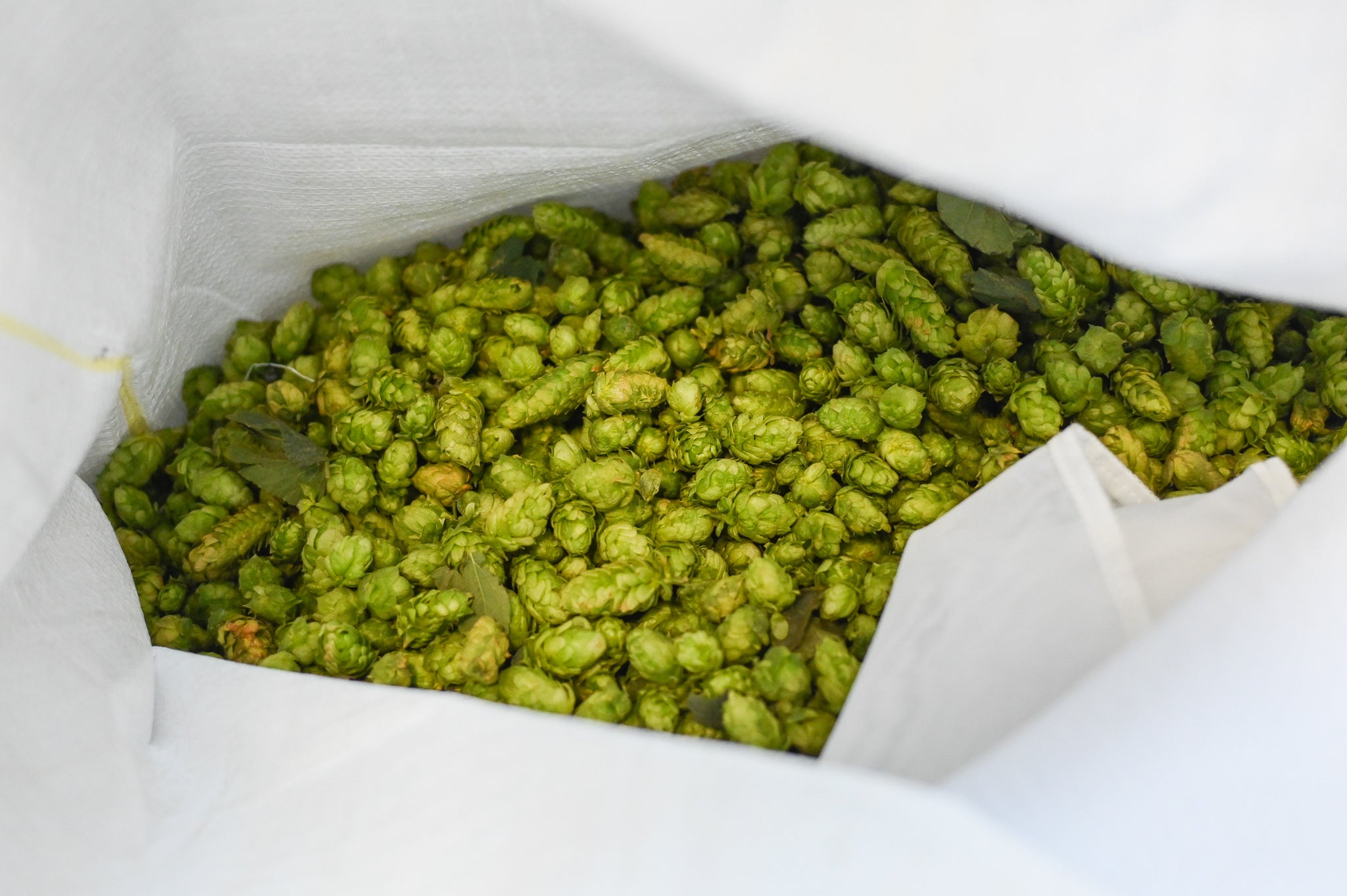
'Tis the Season for Fresh Hops!
Share
Late summer might be the most magical time of year for brewers, especially those of us located in the Pacific Northwest – it’s hop harvest season, and that means fresh hop beers are coming off the line!

It only takes four ingredients to make a beer (grain, hops, yeast, and water), and while all are critically important, it’s often the hops that draw the most attention. Hops are harvested in late August through September. In the Pacific Northwest, where more than 75% of American hops are grown, the harvest can be compared to the annual grape harvest for winemakers in Northern California, with brewers scrambling to obtain limited supplies of a staggering array of hop varieties (most American hops are produced in the Yakima Valley in Washington, and the Willamette Valley in Oregon). The sense of urgency is real, as there is only one opportunity each year to snag the choicest hops, and fresh hops rapidly expire (fresh hops should be used within about 24 hours of harvesting).
Hops usually are dried after being picked – they are put into drying rooms, and are dried with hot air. After drying, the hops are formed into pellets, which are usable for up to three years if stored properly (some dried hops are kept in cones, which last for about one year). Most beer is made using dried hop pellets. The hop drying process should not be confused with “dry hopping”, which is a brewing technique in which hops are added after the boil, which provides an aromatic, hoppy aroma without much of the bitterness that usually accompanies hoppy beers (hops normally are added during the boil, which breaks them down and releases the components that contain bitter notes).

Fresh hop and wet hop beers take a different approach. These beers are brewed during or just after the hop harvest, and have a brief shelf life. “Wet hops” are simply undried hops, which are exceptionally aromatic and have high levels of acidity and oil, resulting in beers with powerful earthy flavors. “Fresh hops” are kiln-dried and kept as whole cones (as opposed to the air drying and pelletizing standard hop process). All wet hops are fresh, but not all fresh hops are wet! Regardless, all fresh hops impart a “green”, grassy, fresh flavor and aroma to a brew, and all expire very quickly. Fresh hops are less concentrated than pelletized, so it takes greater quantities to achieve the desired flavor, making fresh hops unsuitable for producing large amounts of beer.

There can be variances in how breweries use the term “fresh hop”. For example, some beers that are labeled as “fresh hop” use wet, undried hops, while other “fresh hop” beers use the kiln-dried cones. Wet or fresh hops can be used in many beer styles, but are mostly commonly associated with pale ales, IPAs, and other beers with a high hop content.

Everybody’s Brewing has been producing fresh hop beers for years, including the award-winning Fresh N’ Chronic Fresh Hop IPA, which won “Audience Favorite Fresh Hop Beer” at the 2019 Hood River Hop Fest, and long-time favorite Head Stash Fresh Hop IPA. Head Brewer Dave McGinley and his team are deep in the fresh hop brewing process, but Dave found a spare moment to give his take on fresh hop beers, and what makes them special:
Q: Are fresh hop beers more challenging to make? Are there issues with cost, storage, process, etc.?
Fresh hop beers are more difficult to produce. It adds an extra brewing step and cleaning session to the process. This year, we added the fresh hops to the whirlpool when making Head Stash. The hop cost per pound is pretty low, but the hops are really heavy because of the moisture. Fresh hops spoil very quickly, so you sometimes have to adjust the production schedule to accommodate the fresh hop arrival.
Q: What is the process like to obtain fresh hops? Is there enough for all the breweries in our region to go around, or do things get pretty cutthroat?
We live so close to Yakima that we can get a team together and go inspect and pick up the hops in person. That saves a lot of money on shipping costs, since the short fresh hop shelf life requires expedited shipping. There are plenty of fresh hops for everyone – these are hops that we buy regularly, and it’s easier for the hop companies to sell them as fresh hops because they don’t have to finish processing them.
Q: What makes fresh hop beers worth the extra effort and cost?
On the product side, it’s because they have a very distinctive taste that is coveted by many beer drinkers. On the business side, it’s because they sell quickly – it’s not a question as to whether or not they’ll do well!
Q: Are the recipes for Fresh n’ Chronic and Head Stash consistent, or do they change yearly depending on fresh hop availability? Can you tell us from what farms we get our fresh hops, and why you chose what you did?
Head Stash has consistently been using Simcoe. Fresh ‘N Chronic can use any of the three main hops in that recipe. We get our fresh hops from Loza Farms (Wapato, WA), currently the only Hispanic-owned hop farm in the United States. I chose to keep with tradition this year and use the same hops as previous years because they turned out so well.
Q: Is there a standard process for using fresh hops, or is there room for experimentation?
Fresh hops can be used in several different parts of the brewing and aging processes, so there is room to play around. Some common uses are adding fresh hops to the whirlpool after boiling, dry hopping with them, or transferring a beer into a tank filled with fresh hops.
Q: As a brewer, what’s it like living and working in the number one hop producing region in America?
It’s a great region to be in. We are closest to the source, getting the hops at the peak of quality, and we don’t have to worry about our hops degrading during long shipping times or under less than ideal storage conditions. We get to visit the farm and witness every step, from growing to processing. Every time we make the trip, it’s a new and excellent experience!

Everybody’s Brewing is participating in several of the amazing fresh hop beer festivals that occur this time of year. Look for us at the following events:
- Yakima Fresh Hop Ale Festival (Yakima, WA) – October 2
- Hood River Hops Fest (Hood River, OR) – October 2
- Washington Beer Fresh Hop Festival (Redmond, WA) – October 8-9
- Seattle Fresh Hop Festival (Seattle, WA) – October 9